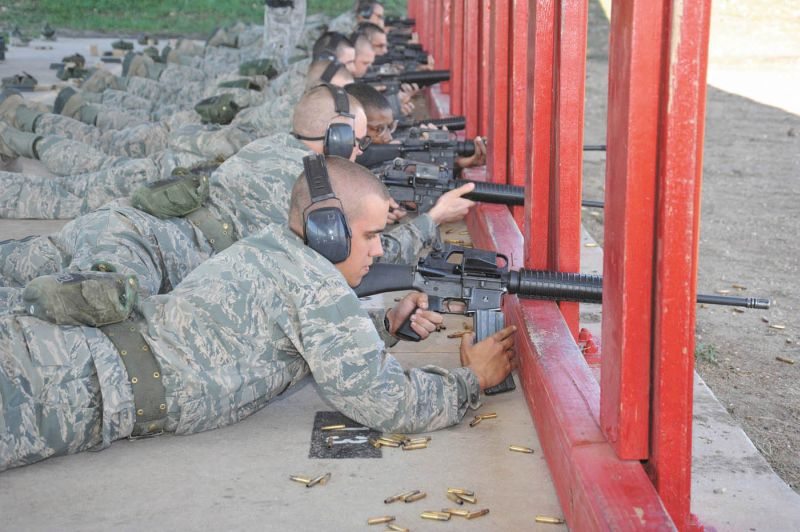Airmen taking the new Air Force Rifle Qualification Course are finding themselves learning more than just basic marksmanship skills.
Changes requiring more intensive weapons training were published in September by the Air Force Security Center and officially took effect Dec. 1.
“Our combatant commanders identified over the last 10 years that we needed to move away from the Cold War-era style of qualification and give our Airmen quality training,” said Master Sgt. Scott Brown, the U.S. Air Forces in Europe combat arms program manager at Ramstein Air Base, Germany. “More and more Airmen are actively engaging the enemy down range, and they need to have a higher standard of weapons training.”
Although there are numerous differences between the new and the old courses, the most significant change is the emphasis on combat engagement and developing shooter survivability skills.
Previously, the “just-in-time” training prior to a deployment or permanent change of station ensured Airmen had the general skills of weapons familiarization, said Senior Master Sgt. Aaron Thieken, the 37th Training Support Squadron superintendent here. The course gave Airmen an understanding of what parts went where, how the weapon functions, or the cycle of operation, and the basic shooter fundamentals — sight picture, breath control and trigger squeeze.
“Those skills are still the building block of any weapons qualification course,” Thieken said. “However, as we continue to support contingency operations with more and more Air Force personnel performing missions outside the wire, it was imperative that our training evolve to meet the changing environment.”
The new course incorporates target acquisition, threat discrimination, multiple-threat engagement, and surviving weapon malfunction and stoppages.
The major changes in the qualification course include more stringent time constraints, required wear of a combat helmet and body armor, movement during fire, and different firing tactics, said Staff Sgt. Marc Rodriguez, a 52nd Security Forces Squadron combat arms instructor at Spangdahlem Air Base, Germany. Also, there are now three skill assessments, or tables, in which some Airmen will participate.
Table 1 encompasses the positions currently in the rifle qualification course. Table 2 involves new movements and short-range marksmanship. Table 3 involves night firing and is primarily for career fields where Airmen require advanced weapons training, like security forces.
As an example of the new course’s difficulty, Rodriguez said that during the move and shoot portion, Airmen will have seconds to advance to the firing line, shoot while standing, crouch, and shoot while kneeling. Rounds not fired within the time limit don’t count toward qualification.
“There are time constraints on all the firing positions to increase your heart rate and make you nervous,” said Tech. Sgt. Robert Duerr, a 52nd SFS combat arms instructor. “At no point downrange will you be shooting at a stationary, small black target with a circle on it. This training will definitely make the individual more competent and confident in their handling of the weapon.”
As a result of the training changes, the number of rounds fired and the additional qualification stages increase the length of classroom training as well as time on the range. Bases that have already used the new curriculum have found the course now takes 10 to 12 hours to complete.
Growing pains are expected with the new course, Duerr said. However, the training is intended to hone Airmen’s weapons skills to provide a better equipped and trained warfighter to combatant commanders downrange. The training may be difficult, but it is not impossible.
Preparation for the course is essential, Thieken said. He recommended Airmen brush up on weapons training by reading their Airman’s Manual.
“Instructors will teach you everything you need to know about the weapon system, but it doesn’t hurt to be prepared,” he said.
(Staff Sgt. Daryl Knee of the 52nd Fighter Wing Public Affairs contributed to this story.)










